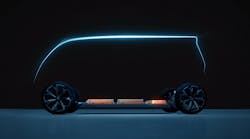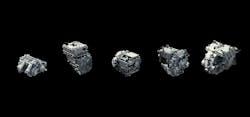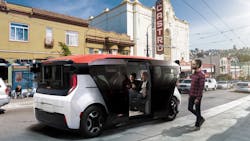Zero crashes, zero emissions, and zero congestion: That is the future that Steve Carlisle, EVP and North American president of General Motors (GM), envisioned for the future of transportation during his keynote speech during ACT Virtual’s events on Nov. 10. A world with no more oil changes, no more tailpipe emissions, and no more steering wheels is just a part of GM’s new electrification strategy moving forward.
Ultium Cells
On July 29, General Motors (GM) broke ground on its new Ultium Cells battery cell manufacturing facility in Lordstown, Ohio. Ultium Cells, a joint venture with LG Chem, will mass-produce Ultium battery cells for electric vehicles and create 1,100 new jobs in Northeast Ohio.
“GM and LG Chem will be investing up to $2.3 billion in Ultium Cells,” Carlisle said. “By sourcing battery cells internally and locally, we can better protect ourselves from future battery and material supply constraints.”
Carlisle explained that the heart of this strategy is a modular propulsion system, and a highly flexible global electric vehicle (EV) platform that is Ultium, which includes proprietary Ultium batteries, proprietary drive units, and a flexible vehicle architecture.
“Let's start with the Ultium battery,” said Carlisle. “This new lithium-ion battery with nickel, cobalt, manganese, and aluminum chemistry uses about 70% less cobalt than what is currently used in a [Chevrolet] Bolt EV battery. We do that by adding aluminum and increasing the amount of nickel. We expect this new battery will offer more range at a lower cost. In addition to other benefits, the platform contains a battery pack that can house 6, 8, 10 or 12 modules, even 24 modules. With 212 module units stacked on top of each other, our propulsion systems can be tailored like stacking blocks to accommodate individual vehicle needs while maximizing park sharing and capacity utilization.”
During Carlisle’s keynote remarks, he stated that the thousands of GM scientists, engineers and designers are working to execute a “historic” reinvention of the company.
Cruise Origin
“The future Ultium platform will help GM to compete for nearly every customer in the market, whether they're looking for affordable transportation, a luxury experience, work trucks, fleet vehicles, or high performance sports car: Ultium is a revolutionary approach to electric vehicle design,” Carlisle said. “Enter Cruise Origin, an autonomous self-driving vehicle that will be well suited for ride sharing and package delivery. This is a vehicle that has no driver and therefore no steering wheel. It is low to the ground, making it easier to enter and exit and the door slide open, which is more pedestrian friendly, they can navigate challenging urban environments safely and efficiently without distraction.”
Cruise Origin, a San Francisco, Calif.-based fleet, will be equipped with the new Ultium platform and will be manufactured at GM’s Detroit and Chevy Assembly Facility, which Carlisle said will also produce a variety of all electric trucks and SUVs.
According to Cruise, with the Origin’s ability to drive day and night and last for more than a million miles, the company will be able to cut up to $5,000 in transportation costs per San Francisco household, per year.
“The Origin is electric — thanks to GM’s Ultium system, which testing indicates million-mile battery life is achievable — powered by 100% renewable energy,” said Robert Graham, vice president of global government affairs at Cruise. “And yet gasoline-powered, single-occupant car buying also increased during the COVID-19 pandemic, especially in cities, where the inside of a new car became another defense against close contact with the unknown.
“Once COVID-19 restrictions ease, and all these new cars converge on our roads along with all the old cars, CO² emissions will increase, as will bad traffic,” said Graham in a Cruise blog post. “The Origin can replace many of these cars, decreasing both congestion and greenhouse gasses, but only if people feel safe enough to share a ride.”
OnStar
Another announcement Carlisle made during his remarks was the permanent arrival of OnStar for all GM vehicles going forward.
“Properly equipped vehicles can communicate a variety of vehicle diagnostic information to drivers and fleet managers like tire pressure, oil and fuel efficiency and preventive maintenance schedules,” Carlisle explained. “Vehicles can link to safety, security and emergency services, stolen vehicle assistance. With OnStar vehicle insights, telematics can provide fleet managers with driver information and real-time alerts, like sudden acceleration and hard-braking speed violations. How long vehicles remain in certain locations can even notify a fleet manager when a vehicle crosses the customizable boundary. OnStar vehicle telematics can find efficiencies and routing and keep track of how a vehicle moves over time and in real time.”
How fleet managers see an electric future
GM recently surveyed nearly 300 fleet managers and learned that when given the opportunity to cite multiple factors for moving toward an electric fleet, nearly two-thirds of the respondents mentioned fuel savings.
“In many cases, electricity costs less than gasoline or diesel,” Carlisle said. “There are no oil changes with electric vehicles, or other maintenance items associated with an internal combustion engine.”
When given the opportunity to state the single-most important reason for going electric, GM reported that nearly half of the fleet managers surveyed said that it was because of their corporate responsibility. Fleet managers who currently have no electric vehicles in their fleets were asked what is preventing them from going electric. According to Carlisle, two-thirds of them said availability of charging stations and more than half of them cited driving reach in cost of charging infrastructure.
“When it comes to charging, it's really as easy as plugging in your phone. Even if you live and work in rural areas. Here's why,” said Carlisle. “Anywhere there is a standard electrical outlet, you have the ability to charge for three key places a fleet vehicle to charge at your facility which is ideal in many large fleet use cases. At the driver's home, where a public charging station is, and where the vehicle is primarily charged will determine what kind of charger is best.”
- Level One charging: Uses 120-volt current, just like a standard household outlet. Charging this way takes more time. So, the key is to plug in every day after work in charge overnight.
- Level Two charging: Done by installing a 240-volt 32-amp charging unit – like the one you plug your dryer or oven into. Level two charges much faster than level one, and are recommended for fleets. Level two charging units need to be professionally installed.
- DC fast charging: Typically, this is what will be found in public charging stations. Today it is more convenient to find and use DC fast charging, though fleets do need to make sure vehicles are equipped with a DC fast-charging port.
“GM is also collaborating with major charge point operators and working with them to further expand their charging networks which will make it even easier to find charging on the go with our energy assist feature that helps drivers locate chargers along the routes, receive real-time alerts about their vehicles range, and get live information on charger availability and more than 41,000 charge plugs across North America,” Carlisle added.
Electric is now
Carlisle ended his remarks by speaking directly to fleet managers.
“Now is the time to begin building an electric fleet,” Carlisle said. “A lot of fleet managers are thinking about electric vehicles these days, either because their respective companies have established clear sustainability goals, or just because they see these [trends] on the horizon and they want to get started. I believe the biggest fear of building an EV fleet is simply the fear of the unknown. And that's why it's so important to get educated early. The key is to jump in now and test the water.”







